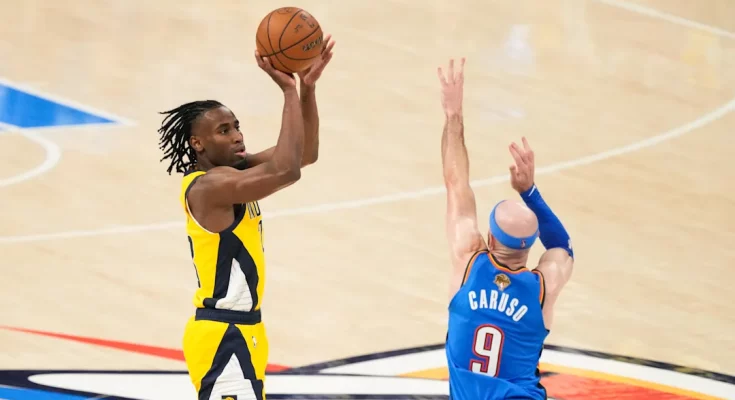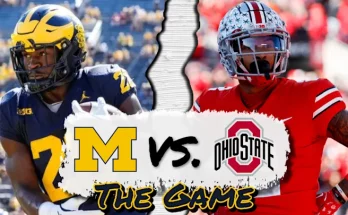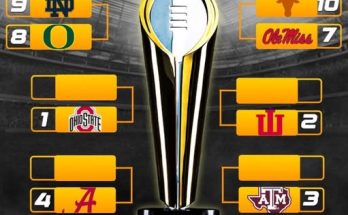In a stunning and refreshingly candid moment that sent ripples throughout the NBA community, Indiana Pacers General Manager Chad Buchanan recently offered a brutally honest assessment of the franchise’s 2024-2025 campaign—referring to it as a “gap year.” While many GMs are often prone to polished, corporate-speak designed to shield teams from controversy and criticism, Buchanan broke the mold and opted for raw transparency. His admission, although surprising, may have finally given Pacers fans the context and clarity they’ve long sought regarding the team’s direction and identity.
Indiana’s 2024-25 season was filled with flashes of promise, gritty performances, and moments of individual brilliance, particularly from rising stars like Tyrese Haliburton and Bennedict Mathurin. Yet, the sum total of the season left much to be desired. The Pacers hovered around the play-in conversation for most of the year, finishing just outside the playoffs in the Eastern Conference. They lacked the consistency and defensive toughness to compete with the elite, and their roster construction—though full of young, exciting pieces—seemed at times like a project still in its developmental blueprint.
So when Buchanan stood in front of reporters during the team’s exit interviews and openly labeled the season a “gap year,” it felt like the organization had finally peeled back the curtain. He explained the term not as an excuse, but as an acknowledgement: the franchise had hit a moment of pause and recalibration. “We weren’t tanking,” Buchanan clarified. “But we weren’t going all in either. We needed to figure out who we are, and more importantly, who we want to be.”
This admission—rare in its frankness—sparked mixed reactions. Some fans felt a twinge of betrayal, interpreting the “gap year” phrasing as confirmation that the front office had lowered expectations and played it safe. Others, however, saw Buchanan’s take as a breath of fresh air—a sign that the organization was aware of its shortcomings and unafraid to take accountability.
The idea of a “gap year” is more common in academia than in professional sports. Traditionally, it refers to a student taking a year off between high school and college to gain clarity, explore options, and prepare more effectively for the future. Buchanan, intentionally or not, applied that same concept to a professional sports team, something almost unheard of in an era where GMs are expected to promise perennial contention and championship aspirations.
In practical terms, Indiana’s gap year meant several things. First, they resisted the temptation to make a splashy, high-risk trade at the deadline. Rumors linked them to multiple big names—most notably Pascal Siakam, OG Anunoby, and even Zach LaVine—but the front office remained cautious. “We didn’t want to mortgage the future for a short-term boost,” Buchanan said. “We believe in our young core and wanted to give them room to grow.”
Second, the Pacers gave ample developmental reps to younger players like Jarace Walker and Andrew Nembhard, both of whom showed flashes of being long-term contributors. The coaching staff, led by Rick Carlisle, prioritized experimentation over results in certain lineups, allowing the team to better understand their roster’s strengths and weaknesses. As Buchanan explained, “You don’t get clarity without putting players in uncomfortable or unfamiliar situations. This year was about data as much as it was about wins.”
Of course, there’s inherent risk in this approach. The NBA is a results-driven league, and fan bases are notoriously impatient. Rebuilding franchises have to walk a tightrope—developing young talent while still remaining competitive enough to attract free agents and satisfy stakeholders. The Pacers, for all their admirable transparency, now enter the 2025 offseason with pressure mounting. Fans will accept one gap year—but not two.
Buchanan seems to be acutely aware of this. In his end-of-season address, he acknowledged the urgency. “Now that we’ve gathered the information we need, it’s time to act on it. There are no more excuses,” he said. “We’ll be aggressive this offseason. We know where our holes are, and we know what we’re looking for.”
So what exactly did the Pacers learn during their introspective year?
For starters, Tyrese Haliburton has cemented himself as the franchise cornerstone. Despite some injury setbacks in the second half of the season, Haliburton’s playmaking brilliance and evolving scoring prowess kept Indiana afloat. His court vision remains elite, and his leadership—both vocal and by example—has grown. Buchanan confirmed the team sees him as a top-tier floor general to build around for the next decade.
Bennedict Mathurin, entering his third year, also took steps forward. While his shot selection and defensive focus still fluctuate, the raw athleticism and scoring potential are undeniable. The Pacers are banking on him making the leap from exciting prospect to nightly contributor. “We believe Bennedict can be special,” Buchanan said. “He just needs the reps and the right system around him.”
One of the bigger revelations came from second-year forward Jarace Walker. Though initially brought along slowly, Walker’s two-way versatility and high basketball IQ earned him extended minutes late in the year. His ability to switch defensively and knock down threes at a decent clip made him an intriguing piece moving forward.
Then there’s the question of Myles Turner. The veteran center has been the subject of trade rumors for what feels like half a decade, yet he continues to anchor Indiana’s defense and space the floor with his shooting. Buchanan remained noncommittal about Turner’s future, offering only that “Myles has been a true professional and a big part of what we do. We’ll evaluate everything this offseason.”
The upcoming summer will be crucial. With cap flexibility and a stockpile of draft assets, the Pacers are poised to make major moves if they choose. Buchanan hinted at being active in free agency and the trade market, but reiterated the importance of aligning acquisitions with the team’s timeline. “We’re not just looking to add talent. We’re looking to add the right kind of talent—players who fit our culture, our identity, and our long-term plan.”
What that identity will ultimately be remains a work in progress. The Pacers have long floated in the NBA’s murky middle ground—too good to tank, not good enough to contend. Buchanan’s “gap year” might be remembered as the season that finally broke that cycle. The acknowledgement of mediocrity is the first step toward transcending it.
Fans, understandably, want more than promises. But there is something to be said for a front office willing to look in the mirror and speak hard truths. In an age where executives often shield themselves behind vague platitudes, Buchanan’s willingness to label the season a developmental pause might be the jolt the organization—and its fanbase—needed.
Whether it was calculated messaging or an honest slip, Buchanan’s words set the tone for a pivotal future. The gap year, by definition, must lead somewhere. It cannot become a permanent holding pattern. If the Pacers fail to take a tangible leap in 2025-26, this past season will be seen not as strategic patience, but as stagnation.



